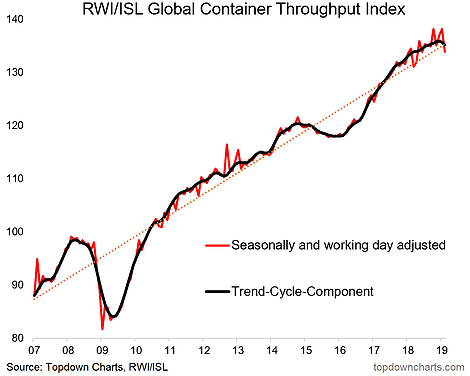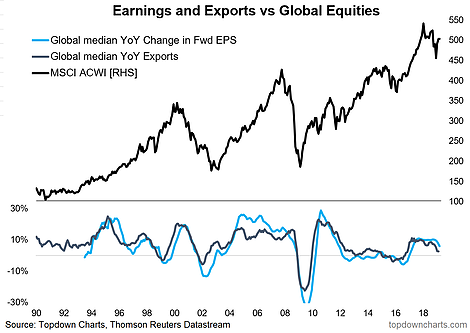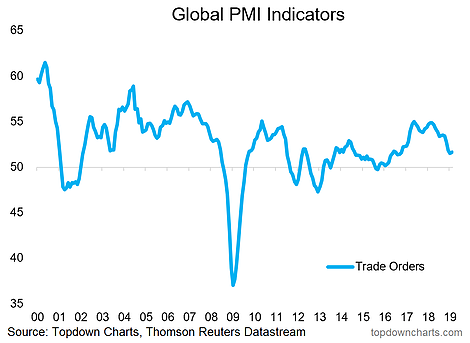This article will present facts of the global trade front and what they mean for investors. The key takeaways on the pulse of global trade (and the global economy) are:
- The higher frequency global trade indicators have struck a particularly soft tone in the past couple of months and it will pay to monitor these closely.
- After breaking out from the post-crisis stagnation, global trade growth risks falling back into the low growth trap.
- Global trade growth patterns play a key role in the path of global equities and are going to be key in determining what comes next in the market cycle.
- The Deflatometer highlights the real weakening in growth, but it doesn't tell us anything about the severity or duration of the downturn, which is something a lot of people have already jumped to conclusions on.
1. High-Frequency Global Trade Indicators
This chart brings in some key high-frequency trade indicators: a. the China Containerized Freight Index - an indicator of China-related general import/export; b. the Baltic Dry Index - an indicator of demand for bulk commodity shipping; c. Global shipping stock relative performance against global equities. The dark grey line provides a summation of the 3 signals, and there has been a clear softening in recent weeks. This is going to be a key chart to watch for signs of further deterioration or indeed (more importantly, given where sentiment is), any signs of recovery.

2. Global Container Throughput Index
The next chart shows what is also a quite timely real activity indicator (the February results were just released). The index tracks port throughput volumes from a representative set of major sea shipping ports. The unadjusted numbers took a major dive in February due to the Chinese New Year shutdowns, but even adjusting for that you can see global shipping volumes have dipped below trend. But perhaps more importantly if you look at the numbers across the past 12 months there hasn't really been a proper slowdown in volumes yet. This might reflect some front-loading of orders to beat the arrival of tariffs, even then, up until last month, things don't look that bad yet (compared to 09 or even 2015/16).

3. Top-down Charts Global Trade Growth Monitor
This chart shows export growth trends across the 63 countries we track. Clearly, there has been a moderation in growth, and that follows what had been a breakout from the 2012-16 stagnation years. What's also interesting in this chart is how ~40% of countries we track saw negative YoY export growth. Just imagine how much worse this chart would have looked if the trade war came during those stagnation years. For things to get back on track here we're going to need to see more accommodative policy (and easier financial conditions), and ideally a resolution to the trade wars - which has introduced a negative uncertainty headwind and real adverse impacts. Otherwise, we risk heading back to stagnation.

4. Global Trade vs Industrial Production Output
This chart simply shows the inter-linkages between global trade volumes growth and industrial production growth. This is one of the reasons why global trade is so important to monitor, and why from a policy standpoint governments should do all they can to promote free and fair trade; and look to enable and reduce barriers/frictions.

5. Global Equities vs Global Trade Growth
To bring it back to markets, this chart shows the path of global equities (MSCI All Countries World Index) and global trade growth and forward earnings growth. Clearly, it's easier for stocks to head higher when earnings and trade growth are expanding than contracting, but there are some nuances to it. Typically the market will lead a downturn in trade growth, but the actual data confirming this will be the thing that determines how much further the market falls (i.e. the difference between market skittishness and actual real economic trends). Likewise, the market will usually bottom before trade growth bottoms, but again the actual real recovery in the data pulse will determine the resiliency or otherwise of the market rebound. Though I lean bullish, at this point we really do need to start seeing some stabilization in these indicators - but that may not come until H2.

6. The Global Deflatometer
The final chart, which appeared in the "10 Charts to Watch in 2019" shows the wave of cyclical deflationary forces sweeping the globe. Equity markets were pricing in a major global recession around the start of the year, and already we've seen a real deterioration in global industrial production growth and corporate earnings. The facts show a slowdown is underway, but what they don't show and what I think too many people are being too quick to jump to conclusions on is the severity and duration of that slowdown. Most people it seems are already predicting a new great recession or financial crisis, but really - it could end up just being a passing growth scare, which is just as common, actually probably more common than a major recession. This is why it's important to remain grounded in the data and keep a cool head when everyone else is losing theirs. So I say turn down the noise, and turn up the charts, and the data and the actual signals, true risk in investing is losing focus on process and being swept away by the crowd.

BONUS CHART
This one shows the global PMI trade orders indicator, but this one is only up to date to February - the next round of data will be released next week and the updated chart will be shared with my clients in next week's macro report -- that's where I save my best charts for.

